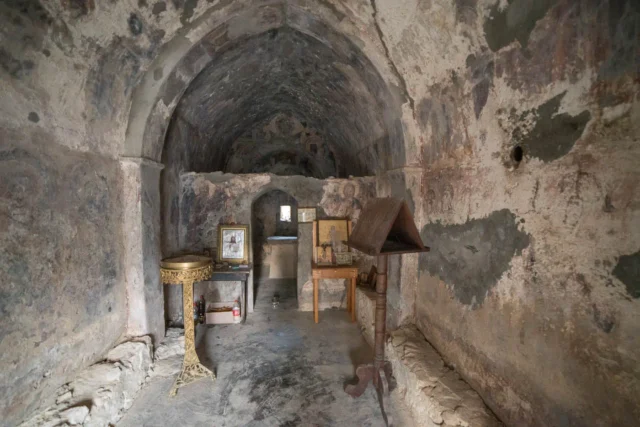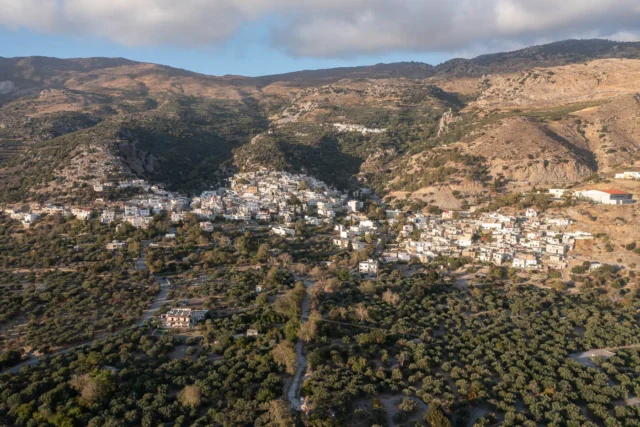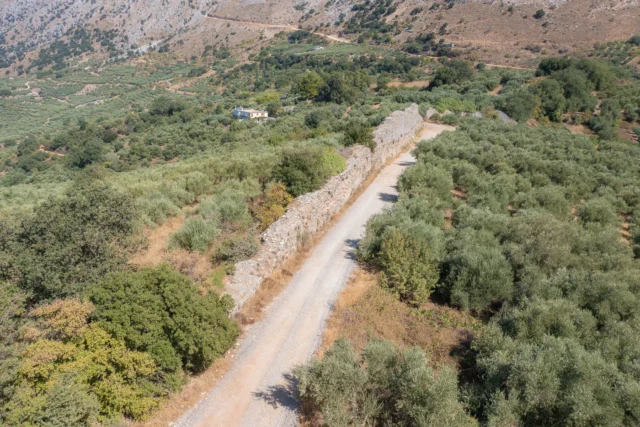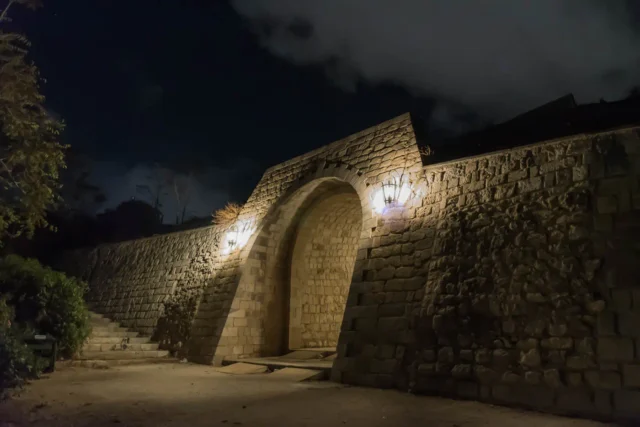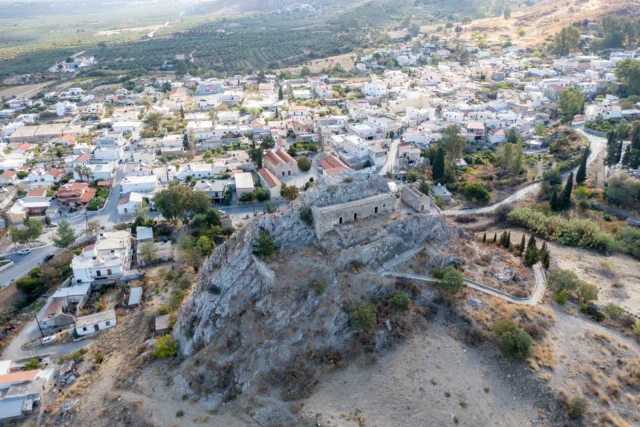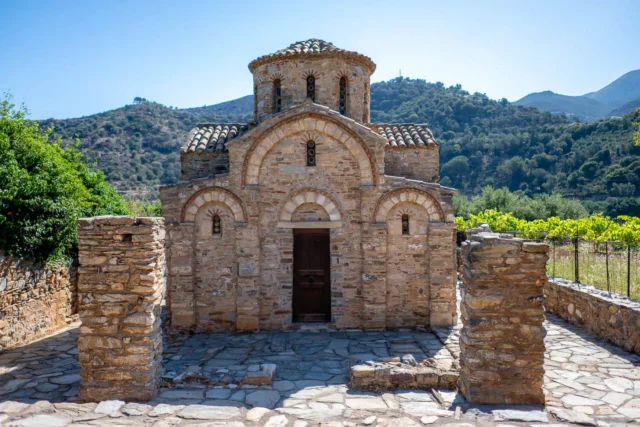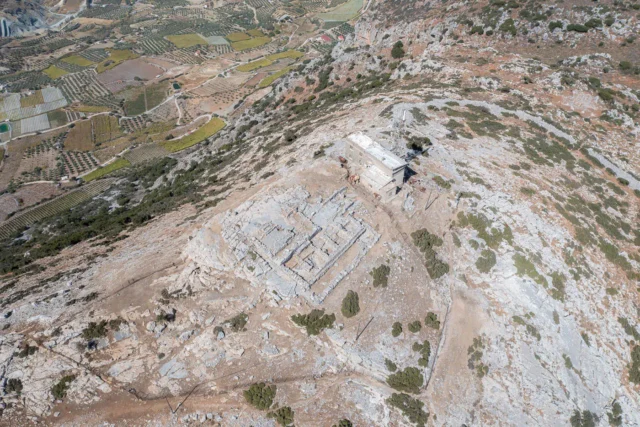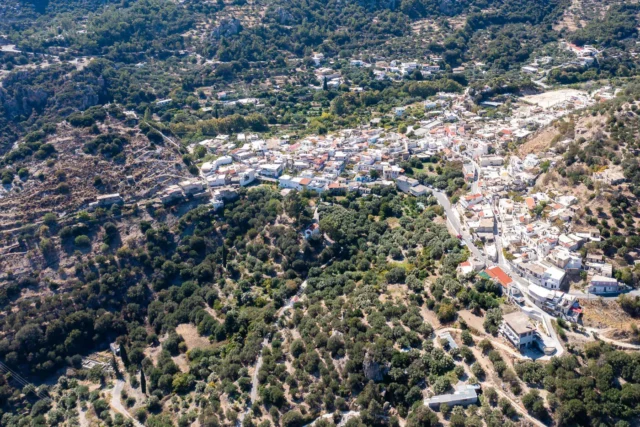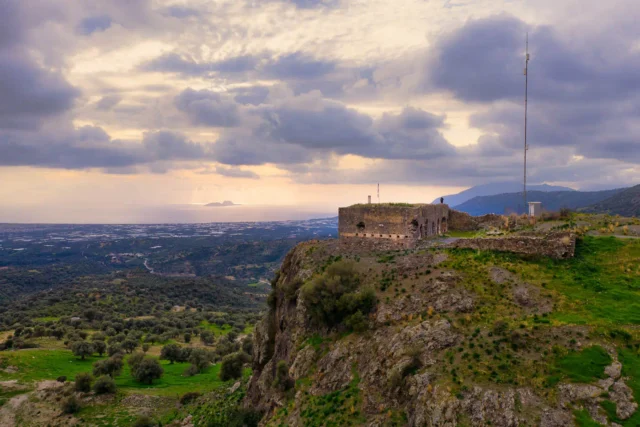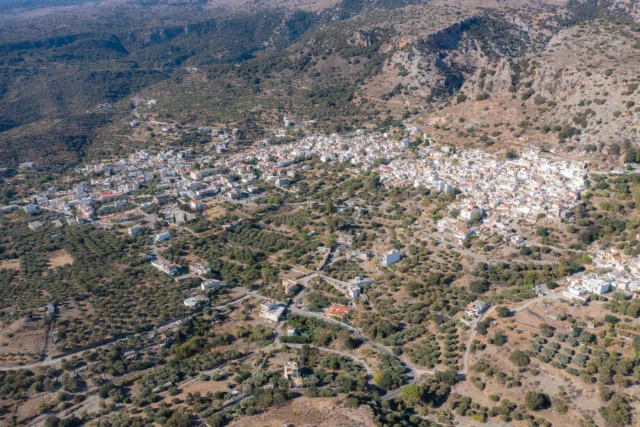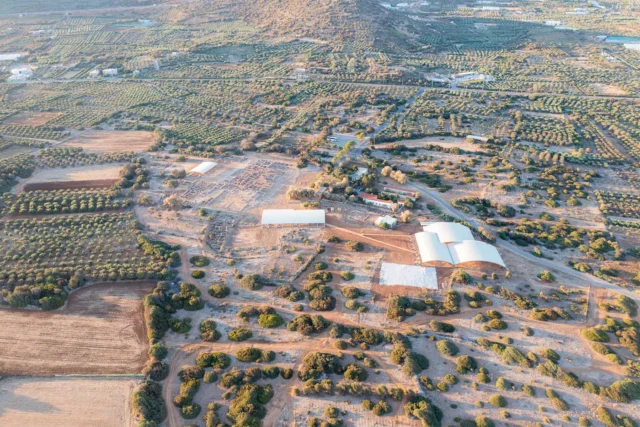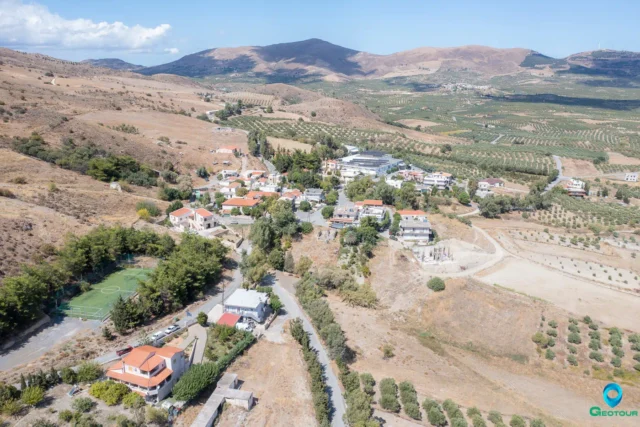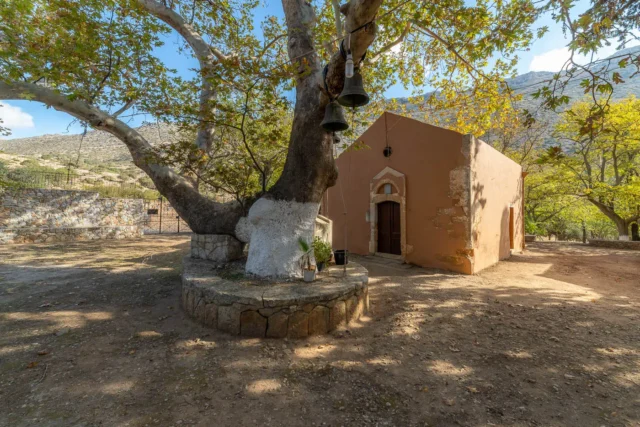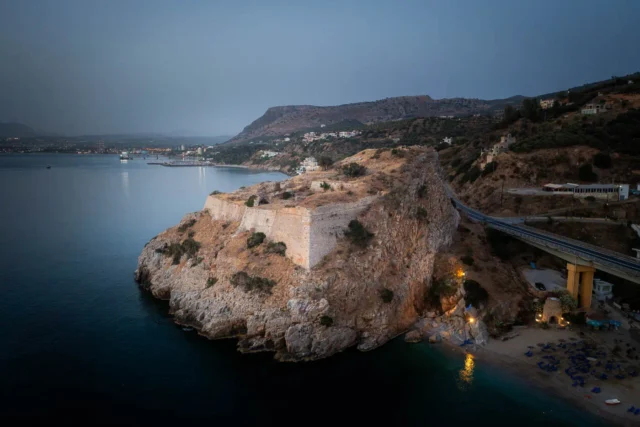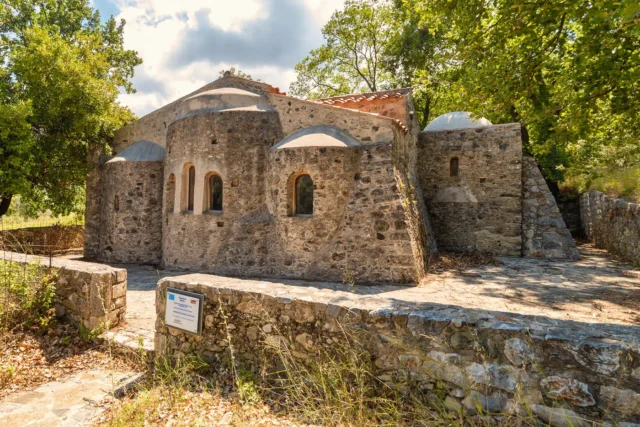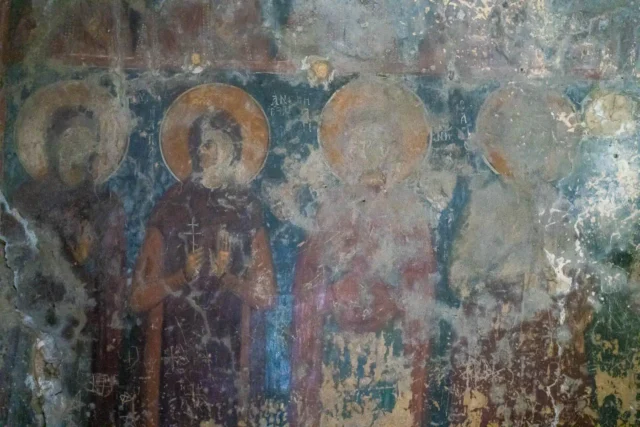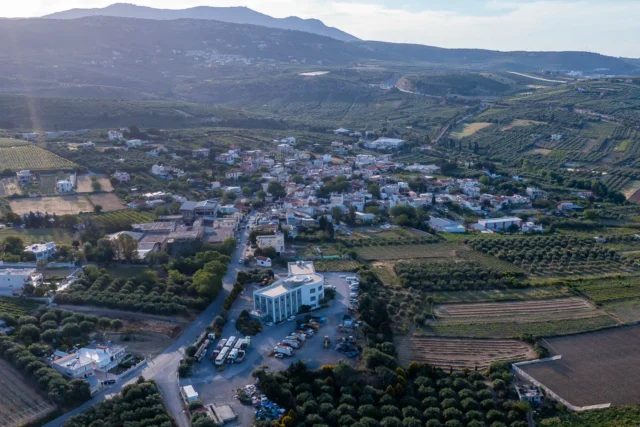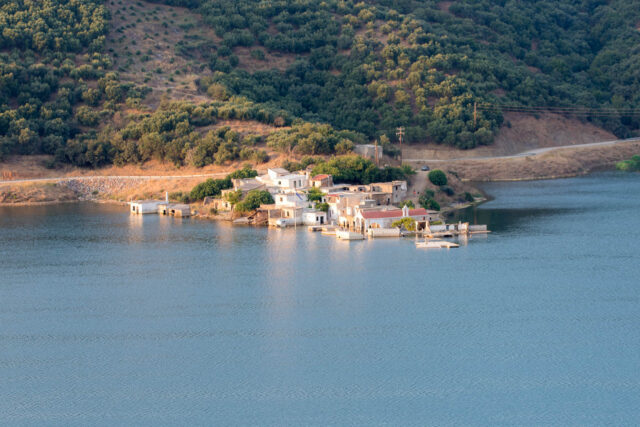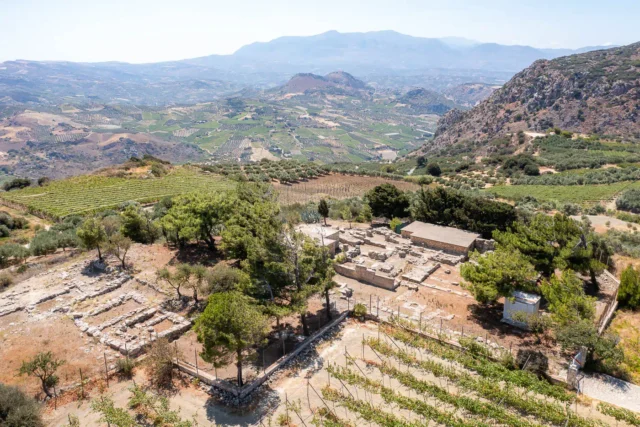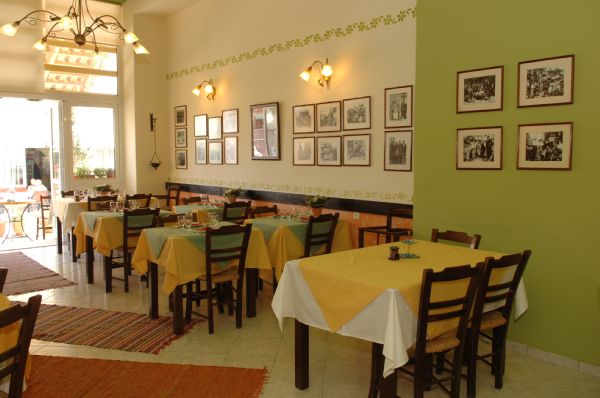
Amiras, Viannos
Amiras, a small village nestled on the southern slopes of Mount Dikti in Crete, boasts a rich history dating back to the Arab occupation of Crete (824-961 AD). Its name, derived from the Arabic word for "ruler," suggests it may have been the site of an Arab amir's residence. The village is tragically known for the 1943 massacre of 117 male residents by Nazi forces, a somber event commemorated by an annual memorial service. Today, Amiras maintains an agricultural economy, cultivating early vegetables and producing olive oil. Its Cultural, Athletic, and Educational Association actively contributes to social events and cultural projects, enriching the community's vibrant spirit. Despite its tragic past, Amiras remains a testament to resilience and the enduring power of community.
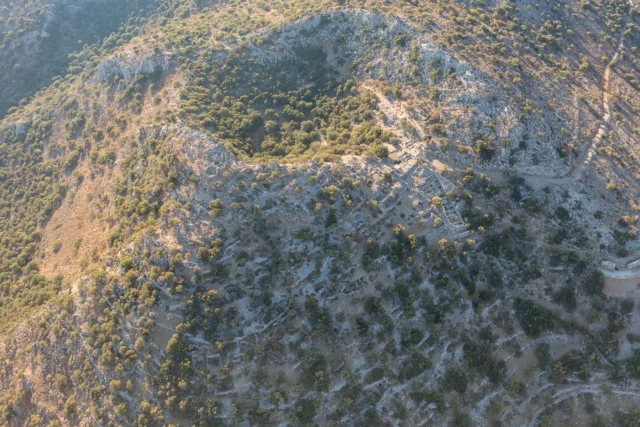
Ancient Lato
8:30 am - 3:30 pm
Lato, an ancient city in Crete, reached its peak after the Dorian arrival. Named after the goddess Leto, Lato was strategically located on a hilltop overlooking the Mirabello Gulf. The city was heavily fortified, with strong walls, gates, and towers. Lato was one of the most powerful city-states in ancient Crete, with a well-organized political structure and a thriving economy. The city's port, Lato pros Kamara, facilitated trade and contributed to its growth. The archaeological site of Lato features well-preserved remains, including the agora, prytaneion, theater, temples, and private houses. Lato was eventually abandoned in the Roman era but was rediscovered in the late 19th and early 20th centuries. Today, it is a popular tourist destination, offering visitors a glimpse into the life of an ancient Cretan city. Lato was the birthplace of Nearchus, a famous admiral who served under Alexander the Great.

Festos (Phaistos)
8:00 am - 8:00 pm
Phaistos, a significant Minoan city in Crete, second in importance to Knossos, located in the Messara Plain. It dates back to 4000 BCE with a palace built in 1900-1700 BCE. The city was destroyed by an earthquake around 1700 BCE and rebuilt with a larger palace. Phaistos had connections with Knossos, Hagia Triada, and Gortyn. Important findings include the Phaistos Disk, Kamares Ware, and architectural remains. After a decline, Phaistos was reoccupied in the Hellenistic period (c. 323-67 BCE) until conquered by Gortyn.

Fournou Koryfi
Fournou Korifi, an Early Minoan settlement near Myrtos village in Crete, dating back to the mid-3rd millennium BCE, provides valuable insights into the Minoan civilization. The settlement, with approximately 90 rooms during its peak, features the "Myrtos Goddess" figurine and evidence of workshops and diverse economic activities. Archaeologists, including Peter Warren, have studied the site's social structures, with interpretations ranging from communal living to a more complex hierarchy. The South House offers a glimpse into domestic life with its weaving room and kitchen. Fournou Korifi's well-preserved remains contribute to our understanding of Early Minoan architecture, social organization, and daily life.

Hierapytna
Hierapytna, located on the southern coast of Crete, was founded in the Geometric period (c. 9th century BC). The city was a major hub for trade and commerce in ancient times and played a significant role in the island's political and military affairs. Hierapytna flourished during the Hellenistic and Roman periods. It became part of the Byzantine Empire after the division of the Roman Empire. Following the Arab conquest of Crete in the 9th century, Hierapytna was abandoned. Modern archaeological investigations have revealed a wealth of information about the city, including its city walls, agora, temple, theater, and private houses.

Kainourgio Chorio, Chersonissos
Kainourgio Chorio, a historic village in Crete, boasts a rich history dating back to the Second Byzantine period. Despite its name, meaning "New Village," it has a long and storied past evident in its well-preserved landmarks. The village, located in the Municipality of Hersonissos, is nestled at an altitude of 220 meters. Kainourgio Chorio is home to the Foscolo Tower, a Venetian-era fortified residence that later underwent modifications during the Ottoman occupation. The village also houses the Church of Panagia and Agia Paraskevi, adorned with surviving fragments of frescoes from the Venetian period. The Venetian wine presses, some of the largest in Crete, stand as a testament to the region's historical wine production. The Wine Museum, donated by Ioannis Papadakis, offers a glimpse into the region's winemaking heritage, showcasing preserved wine production facilities and a collection of wines.

Kamilari, Phaistos
Kamilari is a village in the Asterousia mountains of Crete. Its history dates back to the Minoan era. The village's name, first recorded in 1370, is likely derived from the Byzantine family name "Kamelaris" or the term "Hamilon Oros," meaning "Low Mountain."
Kamilari is archaeologically significant, with nearby sites like the Minoan palace of Phaistos and the Kamilari Tholos Tomb. The discovery of a bothros containing terracotta figures from the Geometric period confirms the area's long history of human presence.
The village's Cultural Association works to preserve local traditions and customs. Kamilari offers a unique experience for visitors to Crete.

Kato Symi, Viannos
Kato Symi is a village nestled in a fertile valley within the Viannos municipality, Heraklion, Crete. The village is surrounded by a mountainous area with the largest forest cover in the region, including the Symi forest, and the Blavopotamos river flows through it. Known for its natural beauty, the valley boasts numerous fruit trees and caves like Zymbraga Spiliaria and Kissospilios. Kato Symi is also rich in history, with significant Minoan-era archaeological finds, particularly the neo-palatial sanctuary of Hermes and Aphrodite at Krya Vrysi, dating back to 2,000 BC. The village has several notable churches, including the Church of the Panagia Galatoktismeni and Nistikoktismeni, built in 1385, and the Church of Agios Georgios with frescoes from the mid-15th century. Kato Symi has a long history, mentioned in the 1583 census as "Simi Catto." It was a site of resistance during the Ottoman period and World War II, where residents bravely fought against German forces. The village's population has declined over the years, but its historical significance and natural beauty remain.

Knossos archaeological site
The Palace of Knossos, located on the Kephala hill south of Heraklion, Crete, is an important site of the ancient Minoan civilization. Occupied since around 7000 BCE during the Aceramic Neolithic period. The First Palace, built during the Middle Minoan IB-IIA period, represents a significant shift in Minoan society from a clan-based structure to a hierarchical one. This monumental building, covering nearly 10,000 square meters on the ground floor alone, served as a hub for administrative, storage, and cult activities. The First Palace also introduced innovative features like storage magazines, showcasing the society's wealth and resources. The New Palace emerged after a massive earthquake that occurred at the end of the Middle Minoan IIIA period, the palace underwent major reconstruction in the Middle Minoan IIIB period. Around 1450 BCE, widespread destruction occurred across Crete, affecting palaces and settlements. While Knossos suffered damage, it wasn't destroyed like other palaces. This period saw the introduction of Linear B, an early form of Greek script used by the Mycenaeans, suggesting their presence at Knossos. The final destruction of the palace, possibly in Late Minoan IIIA2 (1325-1300 BCE), left it deserted, but the town continued to exist. Knossos continued to be inhabited during the Classical, Hellenistic and Roman periods. Two basilicas from the First Byzantine period indicate that the city was still active during this time. Knossos appears to have followed the fate of other urban centers in Crete and declined early.

Myrtos archaeological site
The Myrtos-Pyrgos archaeological site, also known as Pyrgos, is a significant Minoan Bronze Age settlement located on the southern coast of Crete, near Ierapetra. Occupied from the Early Minoan II to the Late Minoan IB period, it provides valuable insights into the development of the Minoan civilization. The site's strategic location and long occupation history make it a key resource for understanding the social, economic, and political dynamics of this ancient society. Excavations have revealed a variety of artifacts, including seals, seal impressions, Linear A tablets, and inscriptions on clay vessels, shedding light on the evolution of communication, administrative practices, and trade networks in Minoan Crete. The site's chronological phases, from Pyrgos I to Pyrgos IV, show a growing cultural sophistication and connections with other parts of Crete, including Malia and Knossos. The final phase, Pyrgos IV, ended with a catastrophic fire that destroyed much of the settlement, marking the end of its prominence.

Olous
Olous, an ancient Cretan harbor city, now largely submerged off the coast of Elounda, was inhabited from the Early Minoan period through the Hellenistic period. Its strategic location in the Mirabello Gulf made it a significant maritime hub, connecting the Eastern and Western Mediterranean. Archaeological investigations, including underwater surveys, have revealed remnants of Minoan cemeteries, fortifications, and possible public buildings. The city's history is intertwined with that of other Cretan powers like Knossos and Lato. Olous was known for its temple to Britomartis and its connections with Ptolemaic Egypt. Today, the site offers a glimpse into Crete's rich maritime past.

The Acropolis of Onithe
The Acropolis of Onithe, a Hellenistic-era fortress potentially dating back to 1400 BC, occupies a strategic position on the Onithe plateau at 638 meters elevation. The site features a pseudo-isodomic wall enclosing a right-angled area with 12-meter sides and remnants of a defensive tower. A steep, natural cliff forms the southern boundary of the acropolis. The site's location provided control over key passages and access to the settlement, underscoring its strategic significance in ancient Crete. Pottery finds suggest the possibility of earlier settlement phases dating back to the Proto-Minoan and Late Minoan periods. The acropolis, referred to locally as 'Ntapia,' meaning fortification, likely played a role in Cretan revolts in 1821, 1878, and 1897.

The Archaeological Site of Onithe
Onithe, an archaeological site near Goulediana in Rethymno, Crete, offers a glimpse into the island's history from the Neolithic period to the Venetian and Ottoman eras. Its strategic location on a plateau provided control over key passages and natural defenses. The site features ruins like the Acropolis with its pseudo-isodomic walls and tower, House A with its abundance of pottery and pithoi, an ancient spring and possible sanctuary, and a Paleochristian Basilica with well-preserved mosaics.
The ancient name of the city remains uncertain, with scholarly attempts to identify it as Osmida or Phalanna remaining inconclusive. It may have been an early settlement center for ancient Rhithymna. The site has yielded artifacts like pottery shards, a bronze zodiac, exquisite metalwork, and sculptures, providing evidence of its prosperity and cultural vibrancy throughout the Minoan, Archaic, Classical, Hellenistic, Roman, and Byzantine periods.

























































